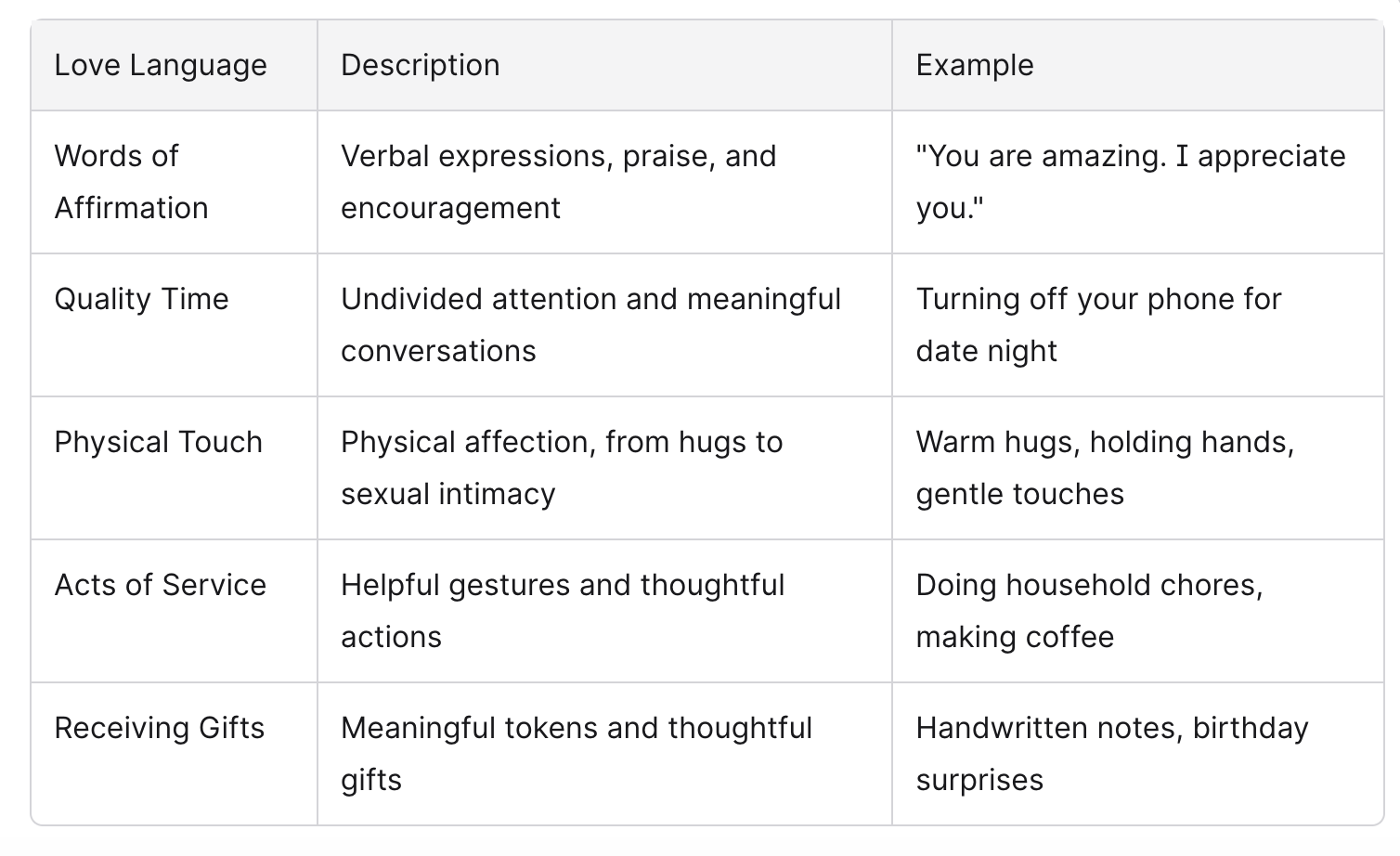Welcome to the ultimate guide on the types of love languages. If you've ever felt like you and your partner were having meaningful conversations in completely different dialects, you're not alone. Love languages explain why some of us swoon at heartfelt commitment while others want a helping hand with the dishes.
Understanding love languages can supercharge your romantic relationships, boost relationship satisfaction, and even improve communication with coworkers and family.
Let’s decode this framework, demystify the science, and sprinkle some charm into your everyday life—whether you’re seeking more quality time, kind words, or just a meaningful gift (hint: it’s not always about diamonds).
What Are Love Languages?
The love languages concept was created by Dr. Gary Chapman, an American author and certified professional life coach. In his groundbreaking book, The 5 Love Languages: How to Express Heartfelt Commitment to Your Mate, Chapman introduced the idea that we each have a primary language for receiving and expressing love.
Why Should You Care?
Diving into your partner’s love language isn’t just social media fodder or relationship therapy gossip. Research reports show that understanding and using the right love language can result in higher relationship satisfaction, stronger emotional connection, and improved conflict resolution. That’s bang-for-your-buck romance, with zero awkward poetry required!
Types of Love Languages (The Famous Five!)
Let’s explore the five love languages, the backbone of Chapman’s love languages framework:

Words of Affirmation
The Power of Spoken Words
If your primary love language is words of affirmation, compliments and kind words land right in your feels. You want love expressed through verbal expressions—“I love you” isn’t just sweet, it’s essential. Digital communication like thoughtful texts, cute memes, or heartfelt emails also scratches this itch.
How to Express Love
- Give compliments freely
- Leave written notes or send digital messages
- Say “thank you,” and mean it
Watch Out For
Harsh criticism or cold silence—these can sting more for lovers of affirmation.
Quality Time
Value of Your Undivided Attention
Those with a quality time love language crave connection through meaningful conversations and undivided attention. The act of being present is central. Zoning out during date night? That’s the cue for relationship improvement.
How to Express Love
- Schedule a quality conversation (no distractions allowed)
- Plan activities that foster shared experiences
- Practice active listening—maintain eye contact, ask questions
Common Pitfall
Answering emails during dinner. Put the phone down, mate.
Physical Touch
Beyond Just Sexual Intimacy
With physical touch as a partner’s preferred language, physical connection translates to emotional expression. It ranges from gentle caresses to holding hands, not just bedroom acrobatics. In fact, for some, a hug might mean more than a diamond ring.
How to Express Love
- Hold hands in public or while watching a film together
- Offer hugs, kisses, and even a reassuring shoulder squeeze
- Initiate affectionate gestures often
Important Note
Physical affection should be attuned to your partner’s comfort level, and not used to “fix” every problem.
Acts of Service
Actions Speak Louder Than Words
If your partner’s love language is acts of service, doing helpful tasks lights them up. This is about easing burdens and expressing heartfelt commitment through thoughtful gestures.
.jpg)
How to Express Love
- Anticipate needs and pitch in without being asked
- Take over chores, especially during stressful times
- Cook a favourite dish, fix something broken
Pro Tip
A lazy approach—or worse, ignoring requests—can leave this type feeling unloved.
Receiving Gifts
Meaningful, Not Materialistic
Receiving gifts isn’t about extravagance but the thought behind the token. For some, a meaningful gift can cement family relationships and romantic love in ways that outlast fancy dinners.
How to Express Love
- Notice what your partner enjoys—favourite snacks, trinkets, mementoes
- Make birthdays and anniversaries special with thoughtful surprises
- Don’t underestimate the power of a “just because” gift
Watch Out
Forgetting important dates or giving generic presents can backfire!
Types of Love Languages in Action
Integrating Love Languages for Relationship Improvement
- Romantic Relationships: Knowing your partner’s love language lets you express love in a way that lands. Using the same love language (or at least trying!) has been linked empirically to higher relationship satisfaction and deeper emotional connection.
- Non-Romantic Relationships: The love languages framework shines for family relationships, workplace relationships, and even long-distance relationships—especially with digital communication standing in for physical presence.
- Professional Relationships: Letting colleagues know you appreciate them (suitable gifts, quality time, or acknowledgement) can boost morale and help with conflict resolution.
The Science of Love Languages
Research shows that while many identify with one primary (and often one secondary) love language, most people appreciate all five in different measures. Matching your efforts to a partner’s preferred love language correlates with greater satisfaction and relationship dynamics that stand the test of different life stages and life circumstances.
- Gender Stereotypes: Research warns against assuming certain genders prefer specific languages. Every individual is unique; be curious, not prescriptive.
- Cultural Perspective: Love languages may be expressed differently depending on family dynamics, cultural backgrounds, and societal expectations. It’s wise to consider context and even consult a mental health professional or certified professional life coach for personalised guidance.
- Research Reports: Empirical studies confirm that learning a partner’s primary language and consistently expressing love through that channel fosters more positive outcomes in both romantic and non-romantic relationships.
Identifying and Communicating Your Love Language
Discover Your Own Love Language
- Reflect on what makes you feel most valued—gifts, words, touch, time, or support
- Recall what you most often request or complain about: it’s likely a clue!
- Take online quizzes based on the love languages concept for a data-driven approach.
Unveiling Your Partner’s Preferred Language
- Observe how your partner expresses love to others
- Listen for verbal expressions: “I wish you’d just hold me,” “It means so much when you help with dinner”
- Engage in meaningful conversations—ask directly, and be open to the answer
Navigating Differences in Love Languages
Integrating love languages—especially when you and your partner don't share the same one—is a lot like learning to waltz. It’s awkward at first, but with patience and practice, everyone feels more in sync, leading to greater relationship satisfaction across the board.
Love Languages at Different Life Stages
Your own love language, and even a partner's, might shift with evolving life stages or life circumstances. What felt like the height of romance in your twenties (physical affection, anyone?) might morph into a desire for acts of service or quality time with every new chapter. Pay attention, adapt, and keep the conversation open.
Common Myths and Criticisms
- You Only Have One Primary Language: Reality check: most people have multiple love languages that matter—and preferences ebb and flow.
- Love Languages Fix All Relationship Problems: While the framework supports emotional expression and relationship improvement, it’s not a replacement for therapy, honest communication, or addressing deeper issues.
- Focusing Only on Romantic Partners: The five love languages help with all types of relationships—family, workplace, friendships, and more.
How to Use Love Languages for Relationship Improvement
- Communicate your needs openly and encourage your partner to do the same
- Regularly check in and ask if your partner’s emotional tank feels “full”
- Mix up your methods: integrate different love languages for holistic emotional connection
When to Seek Professional Support
If understanding love languages isn’t bridging the gap, consider reaching out to mental health professionals or a certified professional life coach. They can help with relationship therapy, navigating rough patches, and crafting new approaches for expressing heartfelt commitment, especially at complicated life stages.
Final Thoughts: Why Love Languages Matter
The types of love languages are much more than buzzwords—they are keys to empathy, connection, and lasting fulfilment in our most important relationships. Whether you express love with thoughtful gifts or crave quality conversation, learning your partner’s love language (and sharing your own) transforms everyday life into a continuous act of meaningful connection and satisfaction.

.png)
.png)
.jpg)



